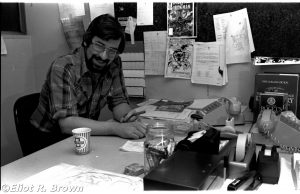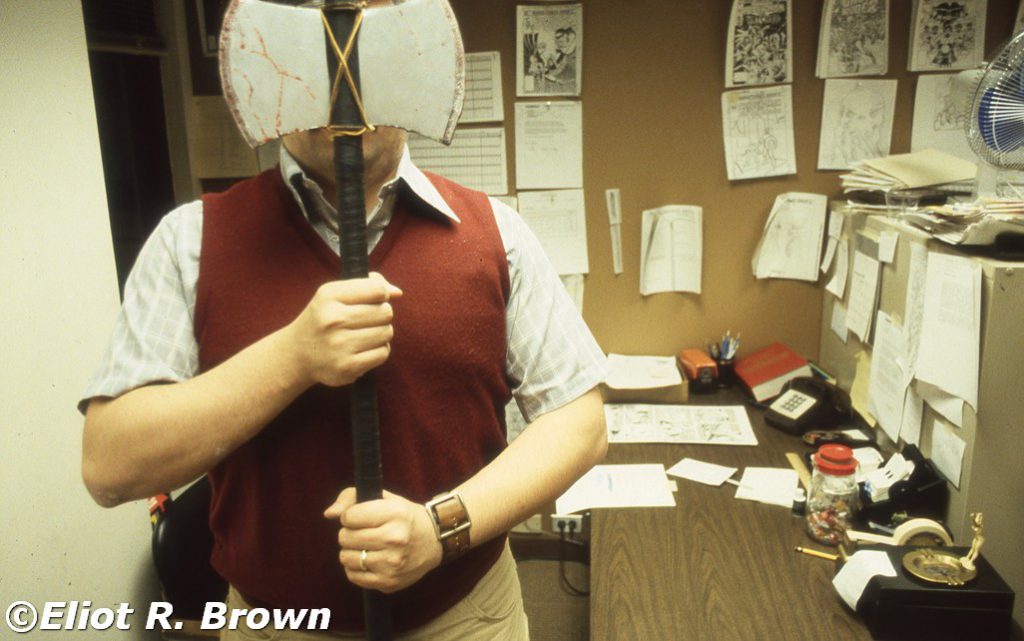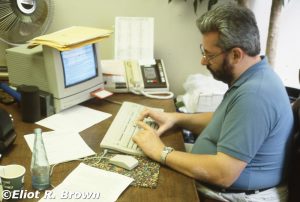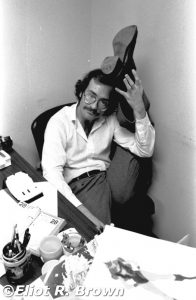Origins

Despite the nick-name, Tom was a very gentle guy. I’ve seen him gently lower a thoroughly inebriated freelancer to the ground and place the toe of his shoe under the skull in order to break the fall—he might, after all, need this person someday. Many is the time I’ve assisted Tom in playing “Bad Cop, Psycho Cop” with a wayward freelancer and Tom has never failed to take the Bad Cop role. Whenever he spoke of his sweet wife, Pat, his eyes would mist over, a tremble would come to his hand as he reached for a restorative beverage and he would turn beet-red from the barely restrained emotions. A gentle guy, like I say.
There are many mysteries surrounding Tom’s actual birth. It seems he was born, exactly when or where is a matter of conjecture. My long association with Tom gives me an advantage, as I have heard most of his stories at least 3-4 times. I can say that Tom’s mother won a cereal-box-coupon contest to tour in a Goodyear Blimp. She was very pregnant at the time, but still game and so up she went. So exciting and fascinating was the trip that apparently her waters broke over the fabled and fetid waters of the Gowanus Canal! Young Tom greeted the world somewhere on the border line between Queens and Brooklyn. In fact, for the first few years of his life, Tom was known as “Goodyear.” He was the first infant to receive a Blimp Pilot License.
The DeFalco family called St. Albans, Queens home (–you will never find a more wretched hive of scum and villainy). Also home to Jackie Robinson, Fats Waller and Lena Horne to name a few. Young Goodyear, ah, I mean, Tom, was in good company. But the remorseless revenuers soon forced the family, now with 7 brothers and as many as 2 sisters, to move on. Practically all farmland back then, to quiet Elmont, Long Island (– also where you will never find a more wretched hive of scum and villainy) was the new family hideout.
“Mr. DeFalco” or Tom’s father, was a butcher (not, I am assured, “The Butcher,” that’s someone else). His mother was a homemaker (not a General Contractor, that’s something else). I met them during a quick visit while driving around Long Island with Tom doing “errands.” It was easy to see where the easy-going approach to life Tom usually showed came from. Mr. and Mrs. DeFalco made me feel like I was a member of the family. Food placed before me, unbidden second helpings and advice on marrying a good Italian girl made me feel as comfortable as if in my own mom’s kitchen.
Tom “always” wanted to be a writer. The most illuminating story I know is that when he was taking a Catholic School art class, he turned in a drawing of a “rock with an antenna.” Agitated, the teacher called him up to the front of the class. (Since Tom can’t draw, his teacher’s consternation is understandable.) When questioned by the teacher, he replied that it was an asteroid in outer space. Behind it was a monster. The antenna was attached to a spaceship that was planning to destroy the Earth! (Devoted Marvel scholars may recognize this as Tom’s most oft used plot. Second only to “High Noon.”) The teacher, taking pity – and perhaps a bribe from the precocious Tom– did not alert the authorities. She did happen to have Tom run errands during future art classes thus unavoidably missing the actual classes –this may have been what Tom later referred to as “running numbers to OTB” (– Off Track Betting—Editori-El). Unfazed by the criticism of so-called teachers, he continued to make his own horribly-drawn, stick-figure comics, well into the 80s.
Even in High School and later in college, he wrote small articles and sold short stories. He attended Le Moyne Jesuit College up in Syracuse, New York. Tom was in good company, a fellow grad was Nicholas J. Pirro, former Onondaga County Executive.
Tom sought to be a teacher with the express idea that he could teach during the week and write on the weekend. But teaching was not for him, the weekends were not enough time to write! Tom spoke of a contentious Creative Writing class where he was the lone proponent of using writing as a way to make a living. Or, to make money, which Tom saw as one of those “practical” things that revenuers and bill collectors often sought. The other students were very much concerned with “ideas,” strength of plot, good characterization, storytelling—all things that Tom would forgo during the rest of his career. Oddly enough, he graduated with a Bachelor of Arts degree in English.
Sure, he had all the trappings of a hard case. He had a thick Brooklyn accent, smoked hideous and cheap little cigars, regularly played poker and knew all sorts of sports crap. He claimed that betting on the “over/under” of any particular football event was, in his case, not betting at all (and he really tried to explain to me what over/under was; I just couldn’t retain it). Tom also made sure to counsel me on the evils of gambling and to never do it myself. He often used cautionary tales about gambling featuring his wife (good and sweet) Pat in order to scare the “urge” out of me! Tom seemed to be a “writer’s writer”—he was the only comic writer I knew who had a regular book-type agent. He wrote so much for regular publishing, he had a couple of pen names, all of which I forget. His current ones, he won’t tell me, Mr. Tight-Lipped-All-Of-A-Sudden.

A prop axe I made for Tom. Specific reason un-remembered. But probably something to do with his briefly-used nick-name, “Hatchet Man” or Tom The Executioner, something like that! This was Tom’s office in the “new” (387 Park) offices. Of note is that Tom had set up a wall of flat files and filing cabinets in front of his deck. The windows are visible behind him. This was a barrier to riled up freelancers with their crofter’s hooks and fiery brands.
Tom DeFalco also did me the glorious service of pulling me out of Production and shoving me into Editorial. This happened soon after the offices moved from 575 Madison down to 387 Park Ave South, in 1982. I had the distinct pleasure of being Tom’s assistant on the “Spider Line” of books, plus Ghost Rider, the first round of updated reprint titles (Amazing) and many others.
As I’ve said in other places, working under Tom did not really teach me how to be an Editor. I slid into the assistant’s position (as rubber-boned funny man Lance Tooks departed) with the system fully in place. In later years, I’ve come to understand that Tom’s Editorial style was finding the right writer or art team for the character and mostly standing back. What I saw then was that huge chunks of any particular book came in, well in advance of a due date and was then easily passed through the rest of the system. We were always several books ahead of the schedule. We could easily get annuals done—in most other offices, the “13th” issue was tough to shoe-horn in. Not in ours.
Among the day’s happier activities was watching Tom bustle in with his leather briefcase and a Donut Fair sugar-encrusted “bow tie” and pull out a handful of script pages to get to work. Pre-computer, Tom made use of a Selectric typewriter as many freelancers did. In order to edit or fix something small or a stretch of dialog, one had to use correction fluid or type up a new paragraph and physically cut it out and Scotch Tape it down. Or both. In Tom’s case, to extremes! Fixes during breakfast included a melee of crumbs and sugar crust being Scotch Taped down to the script. Somewhere in the archives are Tom’s scripts still as sweet as the day they were handed in!
Tom’s scripts were an eye-catching crazy quilt of pieces of paper, taped together, with layers of White-Out and hand-written fixes all over the place. This often meant that an 8-1/2” x 11” sheet of paper would be wider and longer than 8-1/2” x 11”, or a piece of paper would be taped at an off-angle to most of his script pages. Thus, they would not fit on a copy machine. If you use White-Out on Scotch Tape and flex the page a little, chunks of that White-Out will break off. Not perfectly; what you had was a film of old White-Out showing some of what was underneath. But whatever was on top of the White-Out was gone and had to be replaced with writing. One could often find Tom by following a trail of White-Out chips on the carpeting. He finally got a computer late in the game and, of course, knocked his head wondering why he waited so long.

In the heat of one Marvel Universe (that Marvel character encyclopedia with elements of marathon and Sisyphus mixed in) night, Tom was hanging around with us, watching us fight to get one more book “corrected” (according to Editor In Chief and “last word” on any subject, Jim Shooter) and repaired. Tom suddenly stood up, asked for some type corrections with their associated boards and sat down at an empty drafting table. We looked on horrified, expecting to see something like a Hawaiian whirling fire stick dance. But no; Tom surely and steadily, belying all those years of hard drink, sliced with X-Acto blades, aligned type with precision and slathered on One-Coat rubber cement—neatly cleaning it up with a small, filthy rubber cement pick-up (that was on all taborets). We staggered a bit and tried to regain our composure. Tom had never done any production in front of us and his skill level as evidenced by his script page collage work, would not have led us to expect this. He glowered at us, “C’mon, guys… whaddaya think I used to do?” We would never answer that out loud before; now we had a better idea.
Next up, in Part 3:
Elephant’s Memory, High Finance, Tom Interviews Me—Sort Of
